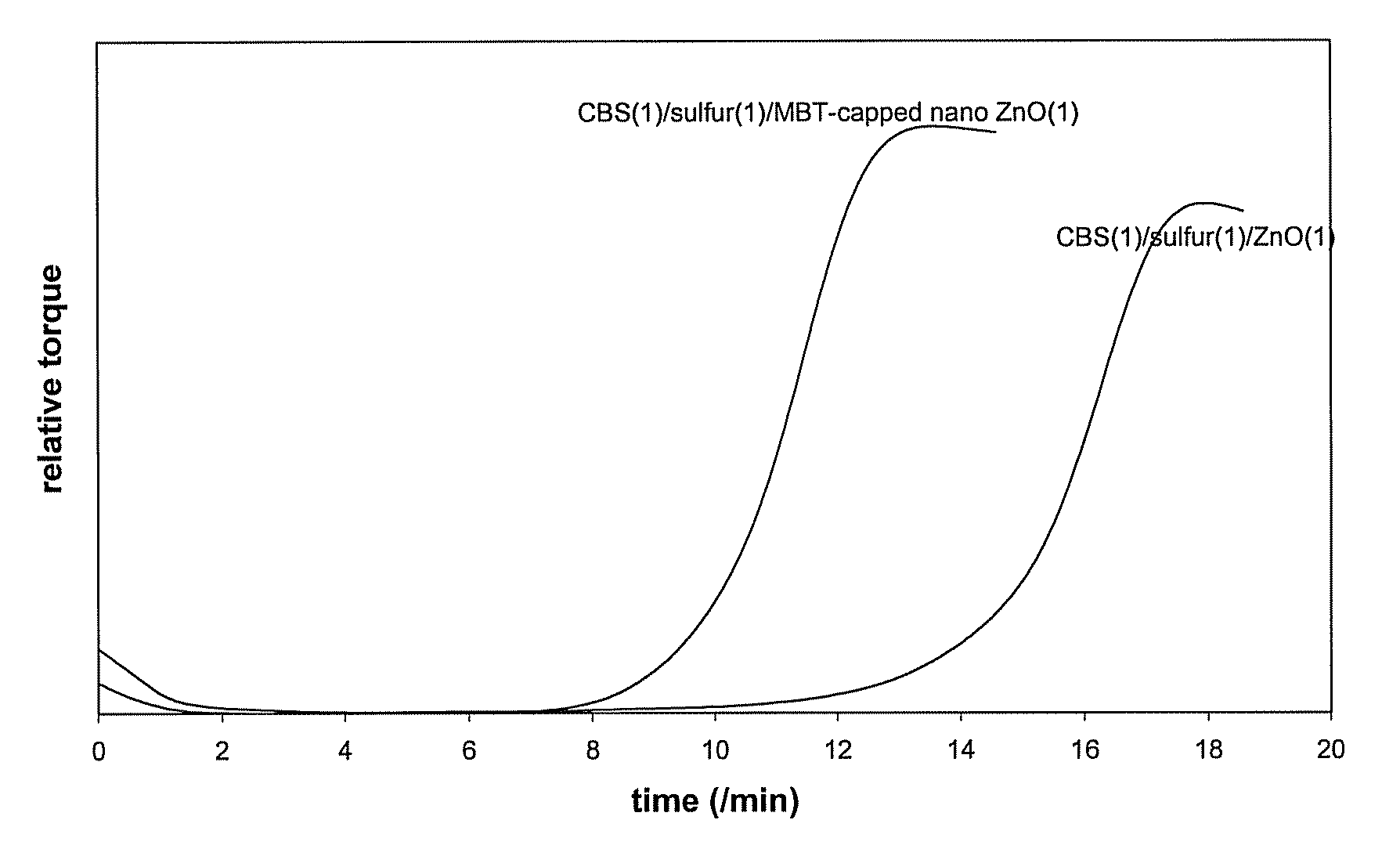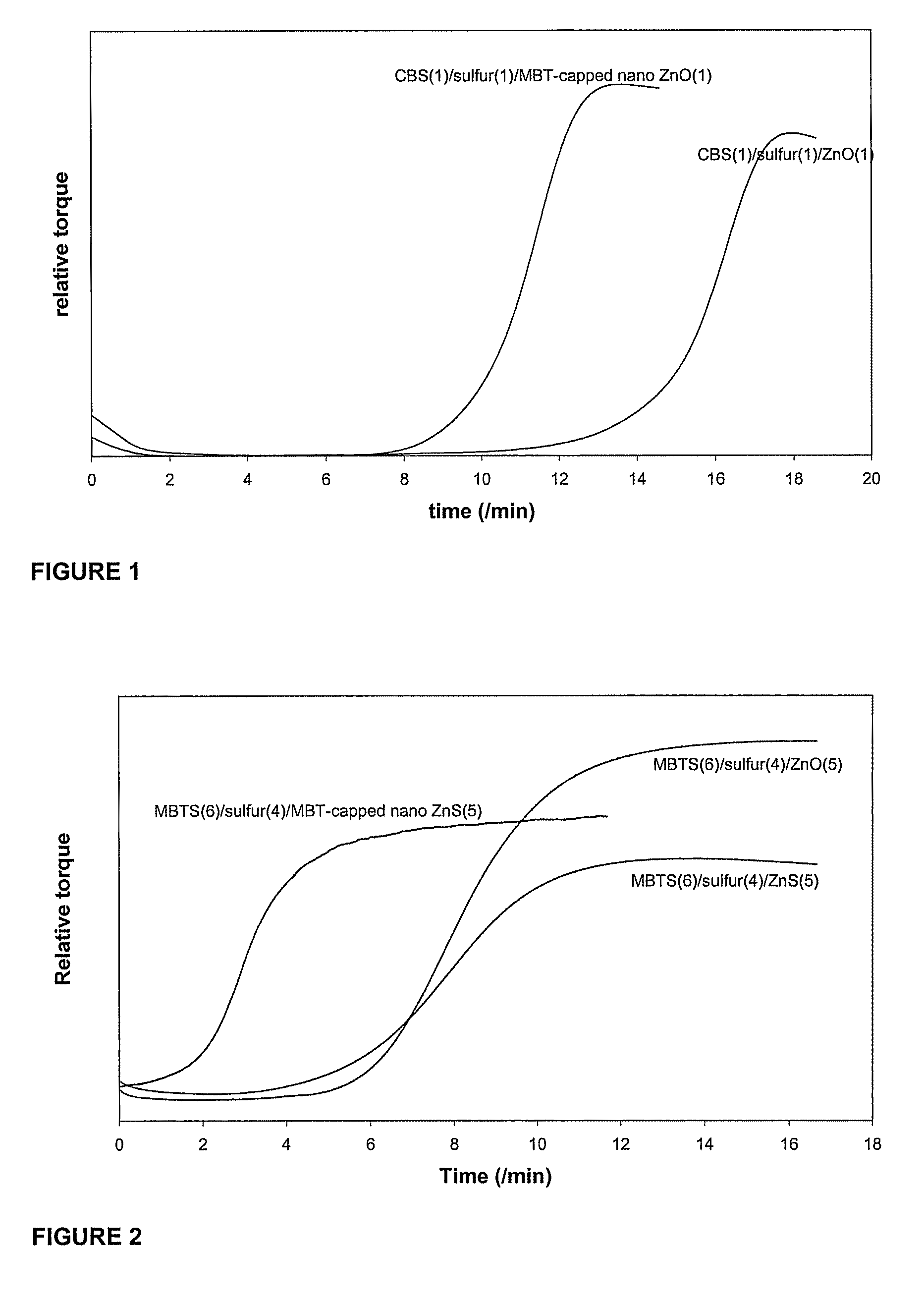Non-polar capped nano transition metal oxides and sulfides
a transition metal oxide and sulfide technology, applied in the direction of mercury compounds, organic chemistry, chemistry apparatus and processes, etc., can solve the problems of inconvenient use of materials, inability to meet the requirements of use, so as to facilitate the solubility of zinc aceta
- Summary
- Abstract
- Description
- Claims
- Application Information
AI Technical Summary
Benefits of technology
Problems solved by technology
Method used
Image
Examples
example 2
[0054]190 mL distilled water and 380 mL iso-propanol were mixed together. This was then divided into two batches. Batch A comprised ⅔ the combined mixture and batch B comprised ⅓ the combined mixture. 5.52 g zinc acetate was added to batch A to make solution A and 7.36 g Na2S (60-62% assay) was added to batch B to make solution B. Both were covered and heated to 30-35° C. to allow complete dissolution. 0.86 g 2-mercaptobenzothiazole was dissolved in 75 cm3 dichloromethane at 30° C. This constituted solution C. Half of solution C was added to solution A at 35° C. Solution B was then added slowly with stirring over ten minutes in 20 cm3 fractions to this mixture. 30 seconds after each addition of solution B, 4 cm3 of the remainder of solution C was added to the combined mixture. The mixture was then kept at 35° C. for a further 10 minutes. The mixture was then allowed to settle, the supernatant decanted and the residue was centrifuged. After excess solvent was removed, the resultant s...
example 3
[0055]190 mL distilled water and 380 mL iso-propanol were mixed together. This was then divided into two batches. Batch A comprised ⅔ the combined mixture and batch B comprised ⅓ the combined mixture. 5.51 g zinc acetate was added to batch A to make solution A and 7.36 g Na2S (60-62% assay) was added to batch B to make solution B. Both were covered and heated to 30-35° C. to allow complete dissolution. 1.23 g tetramethylthiuram disulfide was dissolved in 75 cm3 dichloromethane at 30° C. This constituted solution C.
[0056]Half of solution C was added to solution A at 35° C. Solution B was then added slowly over ten minutes in 20 cm3 fractions to this mixture. 30 seconds after each addition of solution B, 4 cm3 of the remainder of solution C was added to the combined mixture. The mixture was then kept at 35° C. for a further 10 minutes. The mixture was then allowed to settle, the supernatant decanted and the residue was centrifuged. After excess solvent was removed, the resultant slurr...
example 4
[0057]190 mL distilled water and 380 mL iso-propanol were mixed together. This was then divided into two batches. Batch A comprised ⅔ the combined mixture and batch B comprised ⅓ the combined mixture. 5.50 g zinc acetate was added to batch A to make solution A and 7.31 g Na2S (60-62% assay) was added to batch B to make solution B. Both were covered and heated to 30-35° C. to allow complete dissolution. 1.52 g tetraethylthiuram disulfide was dissolved in 75 cm3 dichloromethane at 30° C. This constituted solution C. Half of solution C was added to solution A at 35° C. Solution B was then added slowly with stirring over ten minutes in 20 cm3 fractions to this mixture. 30 seconds after each addition of solution B, 4 cm3 of the remainder of solution C was added to the combined mixture. The mixture was then kept at 35° C. for a further 10 minutes. The mixture was then allowed to settle, the supernatant decanted and the residue was centrifuged. After excess solvent was removed, the resulta...
PUM
| Property | Measurement | Unit |
|---|---|---|
| reaction temperature | aaaaa | aaaaa |
| reaction temperature | aaaaa | aaaaa |
| reaction temperature | aaaaa | aaaaa |
Abstract
Description
Claims
Application Information
 Login to View More
Login to View More - Generate Ideas
- Intellectual Property
- Life Sciences
- Materials
- Tech Scout
- Unparalleled Data Quality
- Higher Quality Content
- 60% Fewer Hallucinations
Browse by: Latest US Patents, China's latest patents, Technical Efficacy Thesaurus, Application Domain, Technology Topic, Popular Technical Reports.
© 2025 PatSnap. All rights reserved.Legal|Privacy policy|Modern Slavery Act Transparency Statement|Sitemap|About US| Contact US: help@patsnap.com



